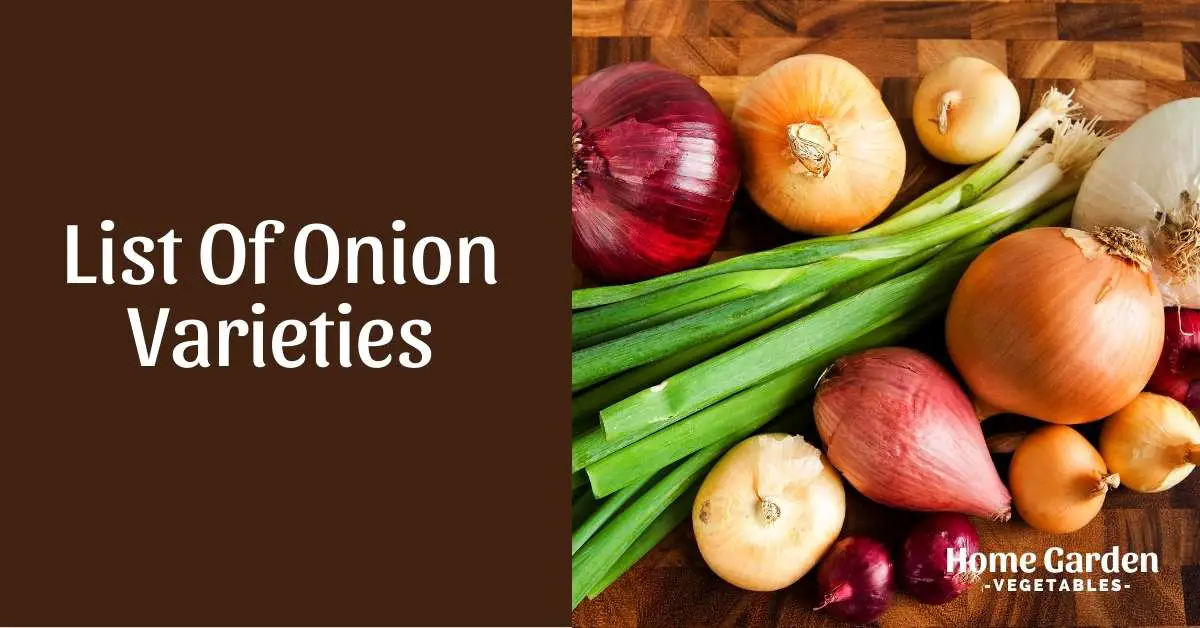You may only have come across two to three onion varieties at best at the vegetable section of the local grocery store, but if you grow your own, there are dozens of attractive onion varieties to enjoy. The different types have their own different uses, flavors, and colors. Onions also differ in the number of days they take to reach maturity.
When choosing onions, other than considering your preferences in flavor and use, you should also think about the climate you live in. It’s not necessary that every variety might thrive in your region. Short-day onions, for example, are better suited to the southern zones (zone 7 and warmer), while long-day onions work better for the northern side (zone 6 and colder) since summer days are longer here.
Reader Poll: What online courses would interest you?
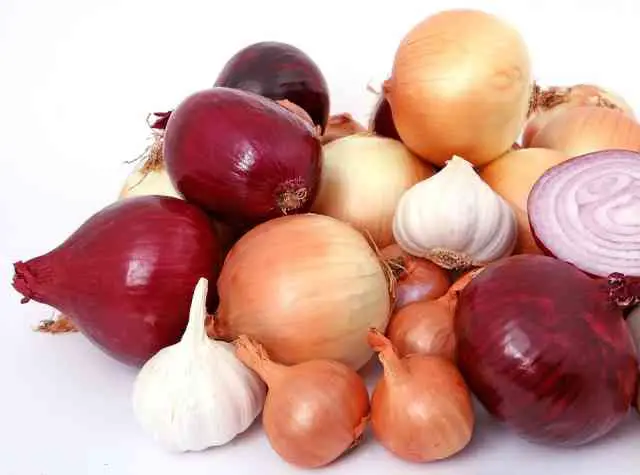
10 Types Of Onions
Most grocery stores sell the yellow variety. You may even have seen red onions and white onions somewhere, but there are yet so many new flavors to explore! Some are perfect for eating raw, while some are great for pickling. Then there are those that work great at spicing up your dishes and soups.
Let’s compare the different kinds of onions and help you pick a unique variety for your garden.
1. Yellow Onions
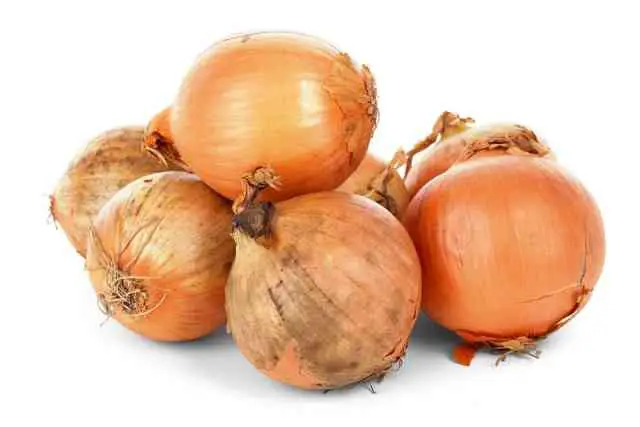
Starting with the most common onions, yellow onions are a kitchen staple in almost every household. They’re also called “brown onions” after their skin color and are available easily at grocery stores at affordable prices. What’s best about yellow onions is that they’re a versatile variety and will work well in many of your everyday recipes.
Subscribe to our newsletter!
The flavor of yellow onions is a nice mix of pungent and sweet, and they become sweeter as you cook them, making them perfect for caramelization in soups and stews. If you’re ever in the mood for French onion soup, yellow onions are the star ingredients!
They store well and are easy to grow. While it’s possible to grow them from seeds, most gardeners plant onion sets since they mature faster. Depending on the variety of yellow onions, they can take 100 days or more to grow from sets. Choose smaller bulbs to plant, spacing them 4 to 6 inches apart in rows. Water and feed them generously through the growing season and harvest them once the tops dry and flop over.
2. Bermuda Onions (Sweet Onion)
Sweet onions are larger than yellow onions and have pale yellow skin. They lack the sharp, characteristic pungency of onions and have a sweeter flavor so they won’t overshadow the other ingredients.
Bermuda onions are a type of sweet onions that got their name from the Island of Bermuda, where they were introduced in the early 1600s and grew so well that they quickly became a staple crop in the region. Bermuda onions have been quite popular in the US, too, up until Texas’s sweet onions took their spotlight. Bermuda onions have a mild flavor that works perfectly in grilled recipes and stuffings. The lower pungency also makes them great for raw applications such as salads and sandwiches.
Bermuda onions are short-day varieties, usually available as seeds or transplants. Seeds are usually sown indoors 6 to 8 weeks before the garden can be worked in spring. Seeds can be grown closer together but space them 4 to 6 inches apart once they are tall enough to be thinned. Long sunny days, consistent watering, and fertilization every 2 weeks help produce bigger onions. They’re ready for harvest in about 90 to 120 days.
3. Walla Walla Onions (Sweet Onions)
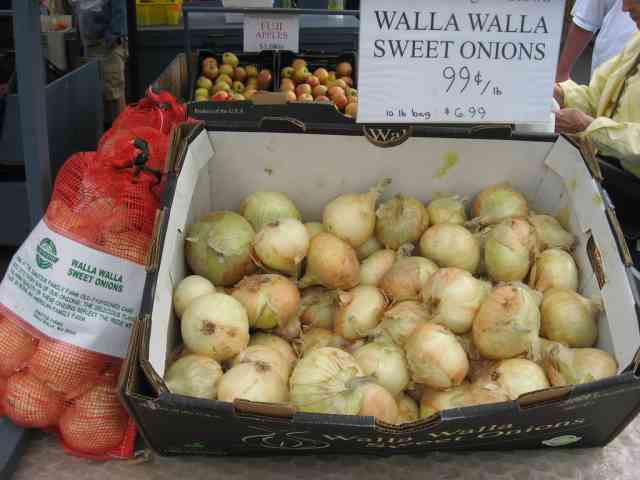
While we’re still on sweet onions, let’s not skip the Walla Walla onions. They’re a popular variety from the Washington State, cherished for their large sizes. When grown in the best conditions, this long-day onion can produce 2-pound bulbs!
Similar to other sweet onions, they have a mild flavor, favoring sweetness over pungency, but since they have a higher water content than other varieties, the shelf-life is lower. Once they’re cured, you can store them in a cool, dark place and consume them within a month. You can eat them raw in salads and sandwiches or lightly cooked in pizzas and other dishes.
They grow best in northern regions and can be started from seeds, sets, or transplants. Growing from sets is the easiest and produces faster results. When planting from seeds, Walla Walla onions are best started in August, so they can overwinter to produce bigger and milder onions. When sown in spring, Walla Walla onions take 150 days to reach maturity when grown from seeds, while fall-sown crop takes about 300 days to grow to their full size.
4. Welsh Onions
Also known as Japanese bunching onions, Welsh onions don’t come from Wales – the name is misleading! They have been a common garden onion in Chinese and Japanese culture since prehistoric times. Several cultivars of Walla Walla onions have been bred over the ages and are being cultivated throughout Asia.
They take little space to grow, and all the parts are edible. Though they don’t produce plump bulbs like the usual onion varieties, they are typically grown for their thickened stems. They are perennial plants with leaves and stems that stay green even during the winters in most climates. Though the leaves may die back if the winters are cold, the plants will grow new shoots as soon as warm spring temperatures set in.
They can be propagated from seeds or divisions and are planted in well-drained, fertile soil, somewhere they can receive full sunlight. Unlike other varieties, they’re not greedy feeders, and side-dressing with compost at the start of each growing season is enough to keep them nourished.
5. Spanish Onions (Sweet Onions)

Spanish onions are often confused with yellow onions, but they are a completely different variety. They’re bigger and have a sweeter and milder flavor that makes them an excellent candidate for omelets, salads, and salsas. Since they have a low water content, they store well but not just as well as yellow onions. For the same reason, if you plan on making onion rings, Spanish onions are your best bet!
Spanish onions are long-day varieties, well-suited to the northern climates, and can be planted as soon as the soil can be worked in spring. Space the sets 4 to 6 inches apart, pushing them 1 to 2 inches deep in the soil. Keep the soil consistently moist and apply a balanced fertilizer every 2 to 3 weeks starting from 2 weeks after planting.
You can harvest green tops once they’re 6 to 8 inches tall, but it will take about 110 days for the bulbs to grow to full maturity. Take the bulbs out carefully from the soil once the tops die and droop over.
6. Sturon
Sturon is a high-yielding long-day variety that produces perfectly globular, medium-sized bulbs with brown skin and yellow flesh. These are traditional varieties that have been grown for centuries for their reliable results and ease of growing.
Sets and seeds are easily available online and in nurseries and are quick to reach maturity in about 80 to 100 days when planted from sets. Plant sets in well-drained, fertile soil. If your garden soil is particularly wet or clayey, consider growing in raised beds.
Water, weed, and feed the plants regularly until they are ready to be harvested by late June or July. Leave them out in the sun to dry for a day or two before storing them in a well-ventilated, dry location. When stored well, Sturon onions can last for several months.
7. Pearl Onions
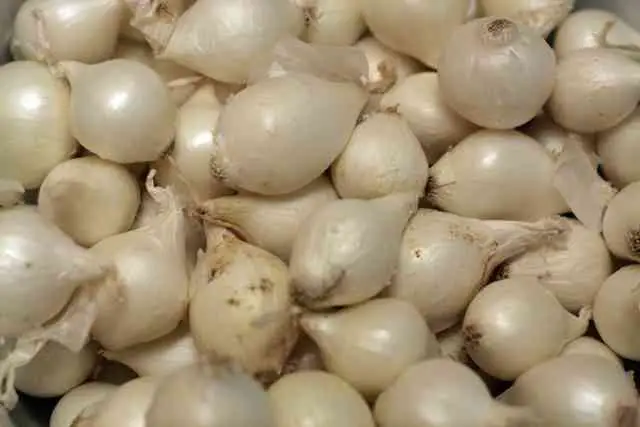
Also called button or baby onions, these are the cutest little onions you can put in a pickle jar! Yes, their small size and mild flavor make them incredible for pickling. Unlike larger onions that require chopping, you can just peel and add whole pearl onions to your dishes for an exquisite presentation!
Most of them are around an inch in diameter with thin white skins and a mild, sweet flavor. Though they take much the same care as a standard onion to grow, they’ll take little space in your garden and will mature much earlier thanks to their smaller size! So if you have a small garden and can’t figure out which onion is for you, pearl onions are just the ones to go with!
They’re started from seeds indoors in moistened potting soil, and the temperature is maintained between 70 to 75°F. The seeds can take over 2 weeks to sprout. The seedlings are allowed to grow on a bright windowsill for several weeks before they can be transplanted in the garden, once the soil can be worked at the start of spring. In areas where there aren’t any chances of extreme freezes, pearl onions can be transplanted as early as late January or the start of February.
You can space them 1 ½ inches apart since they won’t grow too big. Your pearl onions will be ready to be harvested around midsummer once the foliage dries and falls over.
8. Italian Torpedo
This long-day variety has a unique shape and is commonly used in Italian cooking. Unlike the standard round onions, this one has an elongated shape with pinkish skin. The bulbs can grow to about 4 to 6 inches in length. Italian Torpedo is sweet and mild and has a tender flesh.
It takes about 110 days to grow to maturity once the seedlings are transplanted in the garden. Thanks to their slender and longer shape, growing Italian Torpedo means you can fit more onion plants in limited space.
They are best grown from sets and adapt well to northern climates. They prefer growing in cooler climates and are frost tolerant. Offer a consistent supply of moisture to the plants to ensure a good crop. If you want to use them as green onions, you can harvest them within a month, but the bulbs will take longer to reach full maturity.
9. Shallots
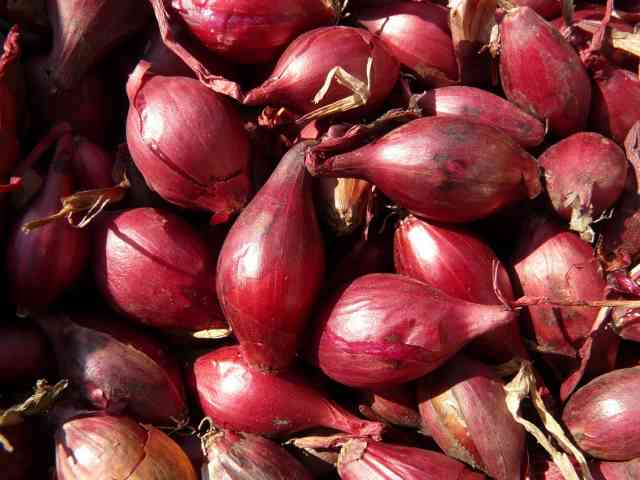
Shallots are members of the allium family, very similar in appearance and taste to regular onions. However, the flavor is richer and sweeter, and instead of growing a single large bulb, it often produces clusters of small bulbs at the base. They have copper-colored or deep purple skins with white flesh and can be used for cooking and pickling in much the same way as onions.
You can plant them from seeds, but sets will mature quicker and are less susceptible to diseases and pests. Plant them in organic soil at a location where they can receive bright sunlight for several hours each day. Space the sets 10 inches apart in rows spaced 16 inches apart.
When planted in spring, clusters of bulbs will be ready for harvest in about 100 to 120 days. Though fall-planted shallots will take longer to mature, the harvested bulbs will be bigger and more flavorful.
10. Egyptian Onions
Also known as Walking Onions, Topsetting Onions, and Tree Onions, these are unique species, Allium x proliferum, similar to the standard onion, A. cepa. It’s a cross between the standard onion, A.cepa, and Welsh Onion.
What makes them unusual is the fact that instead of flowers, this perennial plant produces clusters of top-set bulblets. If the bulbils aren’t harvested, they eventually fall over to the ground and replant themselves, hence the name ‘walking onions’ since they’ll walk across your garden!
The vigorous plant is hardy to zones 3 to 10 and grows well in full sun. You can propagate it easily by just breaking off the bulbils and planting them. The plant can be used in many ways. The shoots, stems, and bulbils are all edible. The onion at the base of the mature plant is also edible but has a very sharp taste.
Conclusion
This was just a selected list of onion varieties you can try out this season. There are several more varieties to explore, each with its unique flavors and appearance. No matter what you choose to grow, you’ll love harvesting fresh, homegrown onions and using them in your favorite recipes!

